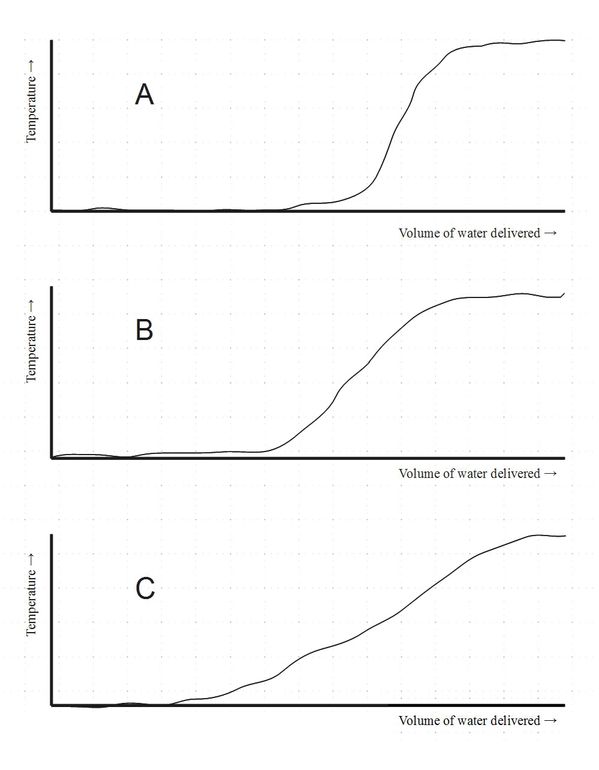Turbulent Thoughts
Turbulence and mixing
Think you understand turbulence and mixing in fluids? Here’s a thought experiment for you. When you’ve thoroughly done the thought experiment, try it in practice.
Water flowing down a pipe slowly isn’t turbulent. As the flow rate increases, it becomes turbulent. Mixing is increased by turbulence, right?
The water in the pipe from your hot water tank or boiler to your hot tap is cold when the tap hasn’t been used for a while. When you run the tap, you can run it slowly, a bit faster, or very fast. Will the temperature of the water coming out of the tap rise over longer or shorter periods in each case?
Actually, there’s a slightly better question than that. Rather than looking at the change of temperature versus time, look at the change of temperature versus volume of water delivered. Imagine you’re filling a series of thirty glasses of water, and measuring the temperature in each. Then draw a graph of temperature versus volume of water delivered. It takes longer to fill the thirty glasses with a slow-running tap, of course!
The diagram shows the results. Think about what’s going on, and see if you can work out which graph is the slow-running tap, and which the fast running one.

Then, ideally, do the experiment and see if you were right. I’ve had a classful of students do it, and most of them got it right – but then, I’d been teaching them about turbulence. I’ve not tried it with an uninitiated class.
(You don’t actually need thirty glasses – you can refill the same one thirty times. Get a friend to write down the temperatures as you read them out. There’ll be a bit of variation in how long it takes you to measure the temperature and chuck the water away, but the results should be clear enough despite the margin of error introduced by this.)
No, I’m not giving you the answer – do the experiment yourself! Or email me if you really want to...
But online, I’ve tried it on several nuclear engineers*. And they got it wrong, and were so confident in their incorrect thinking that they couldn’t be bothered to do the experiment, which is worrying. Turbulence in fluids is an important topic for anyone trying to extract heat from a nuclear reactor, whether to drive a turbine in normal service, or to prevent a meltdown in an emergency.
Several of them also thought that bathwater consistently swirls down the plughole in the same direction in the northern hemisphere, and in the opposite direction in the southern hemisphere. It’s not rocket science†, chaps – and it’s an experiment you can do. Easily. And your misunderstanding of the science behind it is, again, rather worrying.
(I should add that I don’t think the nuclear engineers I studied with under Professor Leslie would have made the turbulence error. Whatever other disagreements I might have had with him, he really knew his stuff on turbulence, and taught it well.)
* So they claimed. Were they really? I don’t know. They were certainly nuclear proponents, and they did know quite a lot about the subject.
† Actually, rocket science isn’t really all that difficult either. Rocket technology rather more so.